SanDisk Ultra II (240GB) SSD Review
by Kristian Vättö on September 16, 2014 2:00 PM ESTRandom Read/Write Speed
The four corners of SSD performance are as follows: random read, random write, sequential read and sequential write speed. Random accesses are generally small in size, while sequential accesses tend to be larger and thus we have the four Iometer tests we use in all of our reviews.
Our first test writes 4KB in a completely random pattern over an 8GB space of the drive to simulate the sort of random access that you'd see on an OS drive (even this is more stressful than a normal desktop user would see). We perform three concurrent IOs and run the test for 3 minutes. The results reported are in average MB/s over the entire time.
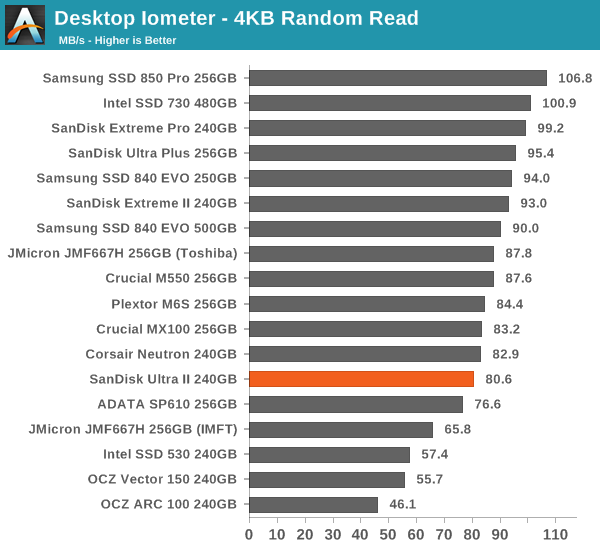
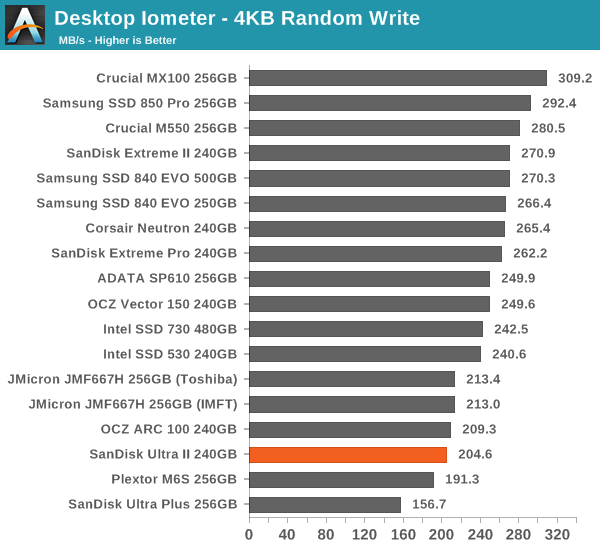
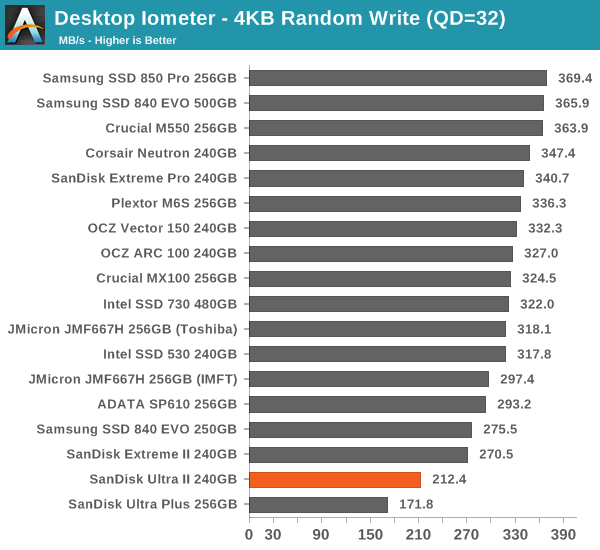
Random performance is decent but not overwhelming. I am surprised that the Ultra II is not faster considering the SLC cache that nCache 2.0 provides. Random write performance especially is a bit slow by today's standards and does not scale with queue depth, but for light client usage the Ultra II should still be fine.
Sequential Read/Write Speed
To measure sequential performance we run a 1 minute long 128KB sequential test over the entire span of the drive at a queue depth of 1. The results reported are in average MB/s over the entire test length.
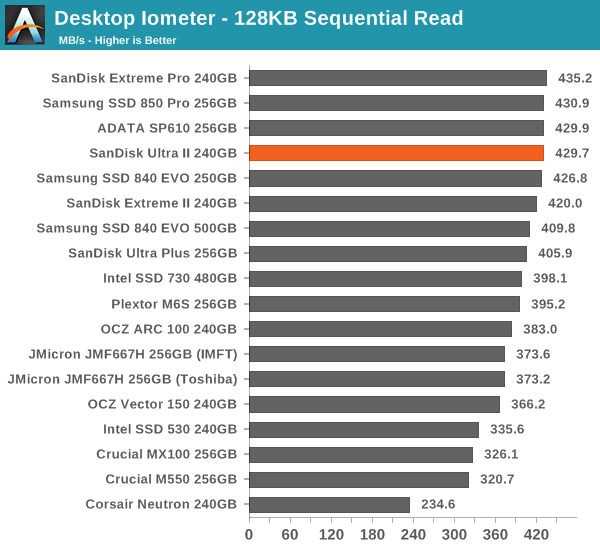
Fortunately sequential read performance is much better, although sequential write performance gets handicapped due to TLC, similar to the 840 EVO.
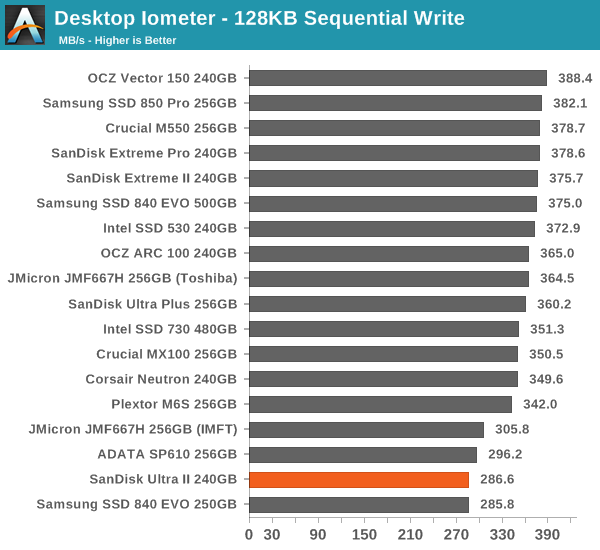
AS-SSD Incompressible Sequential Read/Write Performance
The AS-SSD sequential benchmark uses incompressible data for all of its transfers. The result is a pretty big reduction in sequential write speed on SandForce based controllers, but most other controllers are unaffected.
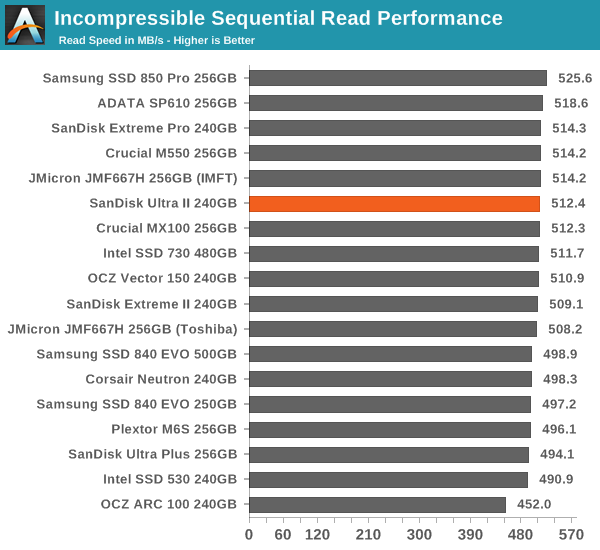











54 Comments
View All Comments
Death666Angel - Saturday, September 17, 2016 - link
That's mostly because the MX100 has been outdated for a while. Crucial/Micron has the MX200 and now MX300 and even a BX100. As long as the MX100 had been in play, it was a great value. But the MX200 and BX100 didn't replace it adequately. I hope the 300 does better.danjw - Tuesday, September 16, 2014 - link
So, basically Sandisk and Micron are both a generation behind Samsung in performance and Micron is a generation behind in features as well. With the 850 Pro offering a 10 year warranty and winning hands down on performance, Sandisk and Micron can for the scraps of the value market.That said, I do hope others, including Toshiba, can get their act together and actually compete with Samsung. I just don't see it happening quite yet.
Kristian Vättö - Tuesday, September 16, 2014 - link
SanDisk offers a 10-year warranty on the Extreme Pro as well and it is close to the 850 Pro in performance while being generally cheaper, so I wouldn't say Samsung is a generation ahead. Micron is a different story, but their focus has never been on the high performance niche.Toshiba's SSD business is more or less OEM only and there are no signs of that being about to change. Their branded side is very small and there is no marketing push behind it, so while Toshiba will remain strong in the OEM side I don't see them having any major role in the retail business.
ZeDestructor - Tuesday, September 16, 2014 - link
Is there any chance you could get a Crucial/Micron M550DC in for review? From a review I read a while back at storagereviews.com, it seemed like a pretty fast drive, up there with the intel DC S3x00 dsrives.Kristian Vättö - Wednesday, September 17, 2014 - link
We reviewed the M500DC when it was launched:http://www.anandtech.com/show/7947/micron-m500-dc-...
Wixman666 - Wednesday, September 17, 2014 - link
I believe he meand that they are a generation behind as far as TLC SSDs go. Since Toshiba bought OCZ, they'll use that brand to push their retail business.MrSpadge - Wednesday, September 17, 2014 - link
That is a very short-sighted view. The 850 Pro is almost twice as expensive as these value drives. If the performance of those value drives is enough (and for many people it will be) than paying twice as much for no real-world benefit is a pretty bad proposition.Sure, 10 years of warrenty sound nice.. but is a small 850 Pro still worth anything in 5+ years? And a shorter warrenty doesn't mean the other drives are guaranteed to fail shortly after that either.
hojnikb - Tuesday, September 16, 2014 - link
Wow, i never though nand dies are actually larger than 128Gbit. I always figered that spare area, bad blocks and ECC stuff comes from GB to GiB conversion (which works out to be ~7%).So does real die capacity differ with other manufacturers aswell ?
hojnikb - Tuesday, September 16, 2014 - link
I wonder if ULTRA II will exhibit the same issues with reading cold files as EVO. It seems that both 840 and EVO are losing on read performance with old files. And since this seems to be limited to TLC drives there might just be a slight chance, that ultra ii could potentially be affected aswell ?Any comments on that ?
iLovefloss - Wednesday, September 17, 2014 - link
I thought it was confirmed that issue was limited to the 840 EVO only with the original 840 and the 840 Pro showing no signs of issues. Honestly, it seems more like a controller issue than NAND issue.